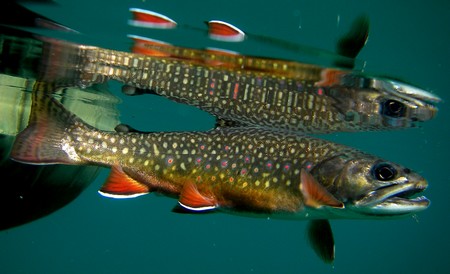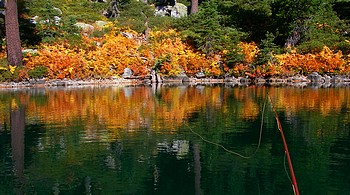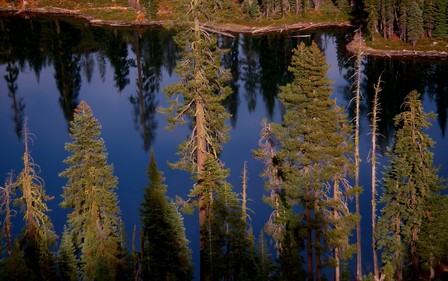Saturday's hike into the backcountry forced me to ask myself why I don't do this more often. In truth, it's been a far better year than most in terms of backcountry fishing, and I've gotten my feet wet in a couple small streams and a bunch of alpine lakes.
 Meet the backcountry brookie - the Official Char of the Trout Underground.
Meet the backcountry brookie - the Official Char of the Trout Underground.Still, Saturday's hike came at the expense of a trip or two on the
Upper Sac, where the fish are apparently happily eating bugs, and for most, the calculus used to choose between 9" brook trout and big Upper Sac rainbows leans towards the river - especially if there isn't a lot of grunting and sweating involved getting there.
Regardless, Saturday morning found me loading my pack with a deflated float tube and enough gear to add 32 pounds to my already considerable tonnage. I was clearly looking at some work.
The hike in along the Pacific Crest Trail was payback enough; stunning views from both sides of the ridgeline, fall colors, and few signs of humanity (this last is hardly surprising - there are far easier places to catch brookies around here).
The Seven Lakes basin is small and heartbreakingly pretty, and making it even more attractive were the brook trout who ate my small wet flies within minutes of my arrival.
 A brookie underwater. Note the mirror image. Will the innovations at the Underground never end?
A brookie underwater. Note the mirror image. Will the innovations at the Underground never end?Later, when the midges came off in numbers and the rises grew frequent, I ran through the usual midge suspects before settling on a Palamino Midge, which worked to the point where it was shredded by better than a dozen brook trout and a
Surprise Monster Bonus Fish - a 15" rainbow who put together a pair of sizzling runs.
 Bonus trout! A 15" rainbow ate the midge. I have no idea where he came from.
Bonus trout! A 15" rainbow ate the midge. I have no idea where he came from.Of course, if it was only about the fish, then I probably wouldn't be there. The backcountry is always beautiful, and the sense of that is only heightened by the isolation.
I heard one ATV, but saw no people and encountered no boom boxes, pushy fishermen, or those loud domestic disputes that seem part and parcel of campground life these days.
 Fall in the backcountry. Oh, the suffering...
Fall in the backcountry. Oh, the suffering...I even fished a rod with an unusual history - an 8' light-action 5wt fiberglass Steffen that was rolled in New Mexico, finished (poorly) in New York, bought online, broken the first time it was fished on the Upper Sac (last year this time), sent back to New Mexico for a new midsection, and then beautifully refinished by Rich Margiotta in Tennessee.
With all the traveling it had already experienced, it only seemed right to move it a little further up a mountain, along a trail, and down a ridge into a lake-filled basin.
After float tubing the lake for a couple hours, my lower body was cold and getting colder, and the last thing I needed was to freeze up my legs before the hike out.
So I got out and decided to warm up by hiking a hundred yards down to another smaller lake, and caught a pair of brookies there.
Right round that time (4:30), the temperature started dropping and some grey clouds rolled in, so I deflated the tube, re-packed my gear, and started the grunt up the ridge to the trail home.
 Good-bye until next year? Maybe. This lake will be frozen all winter and a chunk of spring.
Good-bye until next year? Maybe. This lake will be frozen all winter and a chunk of spring.
The colder weather only emphasized the warm, perfect weather I'd been enjoying, but with fall well underway, the window for any other backcountry fishing is starting to close.
There's still time, but a cold snap at altitude can really turn off the fish, and with the river calling, it's possible I've seen my last backcountry brookie of the year. See you somewhere, Tom Chandler.
 hiking, PCT, brookie, brook trout
hiking, PCT, brookie, brook trout